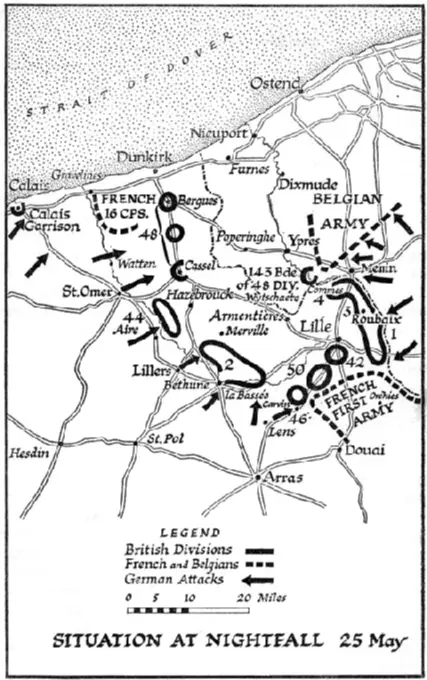he ordered the 5th and 50th Divisions to join the Second British Corps to fill the impending Belgian gap. He informed General Blanchard, who had succeeded Billotte in command of the First Army Group, of his action; and this officer, acknowledging the force of events, gave orders at 11.30 P.M. for a withdrawal on the 26th to a line behind the Lys Canal west of Lille, with a view to forming a bridgehead around Dunkirk.
Early on May 26, Gort and Blanchard drew up their plan for withdrawal to the coast. As the First French Army had farther to go, the first movements of the B.E.F. on the night of May 26/27 were to be preparatory, and rearguards of the British First and Second Corps remained on the frontier defences till the night of May 27/28. In all this Lord Gort had acted upon his own responsibility. But by now we also at home, with a somewhat different angle of information, had already reached the same conclusions. On the 26th a telegram from the War Office approved his conduct, and authorised him “to operate towards the coast forthwith in conjunction with the French and Belgian armies.” The emergency gathering on a vast scale of naval vessels of all kinds and sizes was already in full swing.
The reader must now look at the diagram which shows the general areas held on the night of May 25/26 by the British divisions.

On the western flank of the corridor to the sea the position remained largely unchanged during the 26th. The localities held by the 48th and 44th Divisions came under relatively little pressure. The 2d Division, however, had heavy fighting on the Aire and La Bassée Canals, and they held their ground. Farther to the east a strong German attack developed around Carvin, jointly defended by British and French troops. The situation was restored by the counterattack of two battalions of the 50th Division, which were in bivouac close by. On the left of the British line the 5th Division, with the 143d Brigade of the 48th Division under command, had travelled through the night, and at dawn took over the defence of the Ypres-Comines Canal to close the gap which had opened between the British and Belgian armies. They were only just in time. Soon after they arrived the enemy attacked, and the fighting was heavy all day. Three battalions of the 1st Division in reserve were drawn in. The 50th Division, after bivouacking south of Lille, moved northward to prolong the flank of the 5th Division around Ypres. The Belgian Army, heavily attacked throughout the day and with their right flank driven in, reported that they had no forces with which to regain touch with the British line, and also that they were unable to fall back to the line of the Yser Canal in conformity with the British movement.
Meanwhile, the organisation of the bridgeheads around Dunkirk was proceeding. The French were to hold from Gravelines to Bergues, and the British thence along the canal by Furnes to Nieuport and the sea. The various groups and parties of all arms which were arriving from both directions were woven into this line. Confirming the orders of the 26th, Lord Gort received from the War Office a telegram, despatched at 1 P.M. on the 27th, telling him that his task henceforward was “to evacuate the maximum force possible.” I had informed M. Reynaud the day before that the policy was to evacuate the British Expeditionary Force, and had requested him to issue corresponding orders. Such was the breakdown in communications that at 2 P.M. on the 27th the commander of the First French Army issued an order to his corps, “La bataille sera livrée sans esprit de recul sur la position de la Lys.”
Four British divisions and the whole of the First French Army were now in dire peril of being cut off around Lille. The two arms of the German encircling movement strove to close the pincers upon them. Although we had not in those days the admirable map rooms of more coherent periods, and although no control of the battle from London was possible, I had for three days past been harrowed by the position of the mass of Allied troops around Lille, including our four fine divisions. This, however, was one of those rare but decisive moments when mechanical transport exercises its rights. When Gort gave the order, all these four divisions came back with surprising rapidity almost in a night. Meanwhile, by fierce battles on either side of the corridor, the rest of the British army kept the path open to the sea.
1 comment